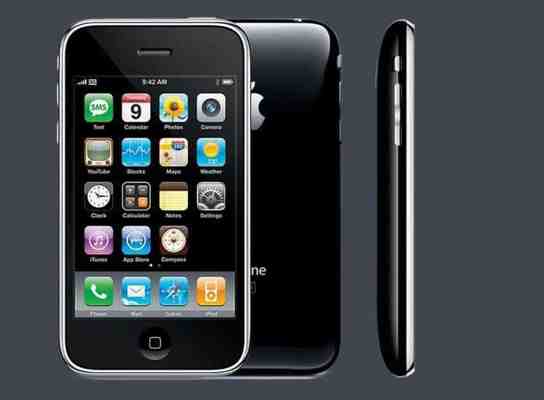iPhone 1st Generation Phones for Sale
Apple iPhone 1st Generation Smartphones

The Apple iPhone 1st generation smartphone was the first iPhone released by Apple in 2007. These devices offer a variety of storage capacities, including 4GB, 8GB, and 16GB models. When selecting one of these Apple phones, you will have several color options to choose from, including black, silver, and white.
When you select one of these iPhones from Apple, there are several features to choose from. The 1st generation smartphone includes a 3.5-inch display that has a resolution of 320 x 480 pixels.
The rear camera comes equipped with a resolution of 2.0 megapixels and includes geotagging technology. The multi-touch touch screen provides access to a proximity sensor, an ambient light sensor, headset controls, and a microphone.
The device is powered by a Power VR MBX 3D graphics processing unit and a Samsung RISC ARM central processing unit. The Apple smartphones operate on iOS 1, iOS 2, or iOS 3.
Other features include:
400-megahertz CPU speed
Eight-hour talk time
A 2.0-megapixel camera for the rear of the iPhone
Weight: 4 ounces
Size: 4.5 by 2.4 by 0.46 inches
These smartphones are compatible with 3G and 4G data networks. Both 3G and 4G refer to the third and fourth generation of mobile broadband internet. To classify as a 3G network, data must transfer at rates of at least 100 kilobits per second while a 4G network must provide data rates of at least 100 megabits per second.
Each iPhone is outfitted with Bluetooth 2.0 compatibility and also offers access to the internet via wireless networks.
The inclusion of quad-band connectivity means that you can call anyone across multiple regions, ensuring that you will reach the person you wish to talk to, even if they live on the opposite side of the United States. These iPhones also provide you with a USB 2.0 port.
Accessories include a USB power adapter for charging, an iPhone headset, a dock, and an iPhone cleaning cloth.
The Apple iPhone includes a rechargeable, built-in lithium-ion battery that lasts up to the following:
8 hours of talk time
24 hours of audio playback time
6 hours of consistent internet usage
250 hours of battery and power standby time
7 hours of video playback time
So, why do you want one of these 1st generation iPhones? If one is still in good condition, it packs a respectable performance and array of features as a smartphone in addition to any intrinsic value as a collector item.
Content provided for informational purposes only. eBay is not affiliated with or endorsed by Apple.
Will Apple discontinue its classic iPhone “s” series?
Recently, there were reports that Apple plans to cut off the “s” suffix of iPhone models. The speculations claim that Apple believes that the use of the “s” suffix is not conducive for product marketing. Consumers subconsciously think that products with the “s” suffix do not change much, thereby reducing the desire to buy. However, Apple officials have not made a clear statement, which means that there is still a possibility of launching models with the “s” suffix in the future. But when you think about it, Apple has not adopted the “s” suffix for more than 3 years. If there are no special changes, Apple really has no reason to re-enable it. The iPhone 13 series is finally here but there is no “iPhone 12s“. Nevertheless, many consider the iPhone 13 series to be a silent iPhone 12s.

Gizchina News of the week Join GizChina on Telegram
Apple has a soft spot for “s” model
As early as 2009, Apple launched its first model with “s” in its name – iPhone 3Gs. After that, iPhone 4s, iPhone 5s, iPhone 6s, and even the expensive iPhone Xs. However, in recent years, Apple has not added the “s” suffix to the iPhone. Nevertheless, it now has a product sequence consisting of a mini version, a normal digital version, a Pro version, and a Pro Max version.
After the iPhone 6s, Apple only launched a model with the s suffix – the iPhone Xs, but unfortunately, due to embarrassing pricing, battery life deviation, and other reasons, the iPhone Xs did not live up to expectations. Since then, the iPhone has never adopted the “s” suffix.
In fact, the “s” used to have meaning back in the day. For the iPhone 3Gs, the “s” stands for “speed”. This was Apple’s most powerful and fastest iPhone at the time. After the death of Jobs, Cook, who succeeded him, did not explain the meaning of the “s” in the iPhone 4s press conference. However, he later stated on an occasion that if the iPhone product name contains a letter, then the letter refers to a flagship feature in the product. Based on this understanding, the “s” in iPhone 4s is likely to represent “Siri”.
When it comes to iPhone 5s and iPhone 6s, Apple officials have become accustomed to no longer explaining product names. But iPhone 5s added fingerprint recognition to unlock “Touch ID” for the first time, which greatly improved the security of the product. Thus, the “s” here could be considered to mean “Security”. As for the iPhone 6s, this classic device is still used by a large number of users and no one can say with certainty what this “s” should mean.
The iPod Classic Died Because Apple Couldn't Get Parts For It
Apple CEO Tim Cook revealed Monday that the company quietly discontinued sales and production of its iconic iPod Classic last month because the company couldn’t get its hands on the parts for the device any longer.
The iPod vanished from Apple’s online stores in September, several weeks shy of the device’s 13th birthday. Cook explained the decision came down to a shortage of parts that couldn’t be replicated without a significant expense to the company.
“It wasn’t a matter of me swinging the ax, saying ‘what can I kill today,'” Cook said during a Monday night interview at the WSJD conference in Laguna Beach, according to Mashable. “The engineering work was massive, and the number of people who wanted it very small.”
Demand for the classic iPod persisted partly because of its ample storage capacity — 160GB of disk space, which was popular among owners of large music collections. Still, those customers formed a dwindling minority as customers shift away from collecting music and toward streaming services.
[Mashable]
Contact us at
